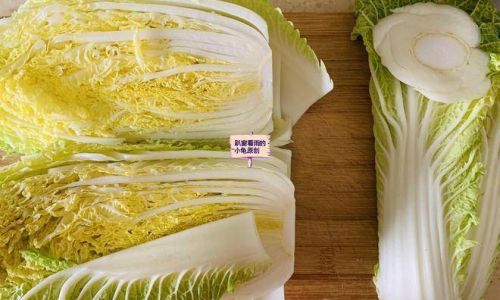Table of content
Introduction
Chinese cabbage, known as Napa cabbage in many parts of the world, is a versatile vegetable celebrated for its crisp texture and mild, slightly sweet flavor. When transformed through pickling, it becomes a tangy, spicy, and deeply umami-rich ingredient that elevates countless dishes. Pickling Chinese cabbage is not merely a culinary technique—it’s a centuries-old tradition rooted in East Asian cuisine, particularly in Korean kimchi, Chinese suan cai, and Japanese tsukemono. Mastering this process allows home cooks to preserve seasonal produce, enhance flavor complexity, and create a pantry staple that can be enjoyed year-round. This article delves into the science and art of pickling Chinese cabbage, offering a comprehensive guide to achieving restaurant-quality results at home. From selecting the freshest ingredients to troubleshooting common pitfalls, you’ll learn how to balance salt, spice, and time to craft a fermented delicacy that tantalizes the taste buds.
Understanding the Basics of Pickling
Pickling is a method of food preservation that uses acidity (either from vinegar or fermentation) to inhibit microbial growth. Fermented pickling, the focus here, relies on lacto-fermentation—a process where beneficial bacteria (Lactobacillus) convert sugars in the cabbage into lactic acid. This not only preserves the vegetable but also creates probiotic-rich, deeply flavorful results. Unlike quick vinegar pickles, fermented pickles require patience, as the transformation unfolds over days or weeks. The key to success lies in controlling salt concentration, temperature, and oxygen exposure.
Selecting the Perfect Chinese Cabbage
The foundation of great pickled cabbage starts with fresh, high-quality produce. Look for Napa cabbage heads that are firm, compact, and free of blemishes. The leaves should be crisp, with a vibrant green hue on the outer layers and pale yellow inner leaves. Avoid cabbages with wilted leaves, soft spots, or a strong sulfurous odor, as these indicate age or improper storage.
- Size Matters: Smaller heads (1–2 pounds) are ideal for home pickling, as they ferment more evenly and are easier to manage.
- Seasonal Considerations: Cabbage harvested in cooler months tends to be sweeter and crisper, yielding superior pickles.
Essential Ingredients and Tools
Ingredients
- Chinese Cabbage: 2 medium heads (about 4–5 pounds total).
- Salt: 3–5% of the cabbage’s weight (preferably non-iodized sea salt or kosher salt).
- Aromatics: Garlic (10–15 cloves), ginger (3–4 inches), scallions (1 bunch).
- Spices: Korean chili flakes (gochugaru, ½–1 cup), fish sauce or shrimp paste (optional, for umami).
- Sweeteners: Sugar or rice syrup (1–2 tbsp, to balance acidity).
- Add-Ins: Daikon radish, carrots, or Asian pear (for texture and sweetness).
Tools
- Fermentation Vessel: Glass jars (1–2 gallon capacity), ceramic crocks, or specialized kimchi containers.
- Weights: Glass or ceramic weights to keep cabbage submerged.
- Gloves: To protect hands from chili sting.
- Knife and Cutting Board: For slicing cabbage and aromatics.
Step-by-Step Pickling Process
Step 1: Preparing the Cabbage
-
Clean and Trim: Remove outer leaves, halve the cabbage lengthwise, and rinse under cold water. Trim the core if tough.
-
Salt the Cabbage:

- Dry Brining: Sprinkle salt between layers, using 1–2 tbsp per pound. Let sit for 2–4 hours, flipping occasionally.
- Wet Brining: Dissolve salt in water (3 tbsp per quart) and submerge cabbage for 6–8 hours.
Why salt? Salt draws moisture from the cabbage, creating a brine that inhibits harmful bacteria while feeding lactobacilli.
-
Rinse and Drain: After brining, rinse cabbage under cold water to remove excess salt. Drain thoroughly in a colander for 30–60 minutes.
Step 2: Preparing the Flavor Base (Jangajji)
- Aromatics: Mince garlic, grate ginger, and slice scallions.
- Spice Mix: Combine chili flakes, sugar, fish sauce, and 2–3 tbsp of the cabbage brine to form a paste.
- Customize: Add grated daikon, julienned carrots, or pear for sweetness and crunch.
Step 3: Combining and Massaging
- Layer Cabbage: Place cabbage in a large bowl and rub the flavor paste into each leaf, ensuring even coating.
- Massage Gently: Work the mixture into the cabbage for 5–7 minutes to soften fibers and release juices.
Step 4: Fermentation
- Pack the Jar: Transfer cabbage to the fermentation vessel, pressing down firmly to eliminate air pockets.
- Add Weights: Use a clean stone or glass weight to keep cabbage submerged in brine.
- Cover Loosely: Use a lid, cloth, or fermentation lock to allow gas to escape while blocking contaminants.
- Ferment at Room Temperature:
- Mild Flavor: 2–3 days (60–70°F/15–21°C).
- Tangy Depth: 5–7 days.
Taste daily—fermentation slows below 40°F (4°C) and accelerates above 75°F (24°C).
Step 5: Maturation and Storage
- Refrigerate: Once desired tanginess is achieved, move to the fridge to halt fermentation.
- Shelf Life: Properly fermented cabbage lasts 3–6 months, developing deeper flavor over time.
Troubleshooting Common Issues
- Mold or Yeast: Skim off surface growth; ensure cabbage is fully submerged.
- Mushy Texture: Over-fermentation or insufficient salt. Reduce salt next time or ferment for shorter periods.
- Too Salty: Soak in fresh water before serving.
- No Bubbles: Check salt concentration (too high inhibits bacteria; too low allows spoilage).
Creative Variations and Pairings
- Spice Levels: Adjust chili flakes for mild to fiery heat.
- Vegetarian Options: Replace fish sauce with miso or soy sauce.
- Global Twists: Add turmeric for Indian-style pickles or caraway seeds for a European flair.
Serving Suggestions:
- Kimchi Fried Rice: Stir-fry with day-old rice, eggs, and sesame oil.
- Soups and Stews: Add to tofu stews (soondubu) or ramen broths.
- Sandwiches: Layer with grilled meats and avocado.
Health Benefits of Fermented Cabbage
Fermented cabbage is a nutritional powerhouse, offering:

- Probiotics: Supports gut health and immunity.
- Vitamins: Rich in C, K, and B vitamins.
- Antioxidants: Combats inflammation and oxidative stress.
Conclusion: The Joy of Homemade Pickles
Pickling Chinese cabbage is a rewarding journey that connects us to ancestral traditions while empowering modern kitchens. Whether you crave the fiery kick of kimchi, the earthy tang of sauerkraut, or a personalized blend of spices, the principles remain the same: respect the ingredients, embrace patience, and savor the transformation. With practice, you’ll refine your technique, discovering the perfect balance of salt, spice, and time that makes your pickled cabbage uniquely delicious. So grab a head of Napa cabbage, don your apron, and let the fermentation magic begin!
Final Tip: Label jars with dates and ingredients—you’ll forget the details, but your future self (and taste buds) will thank you.





0 comments